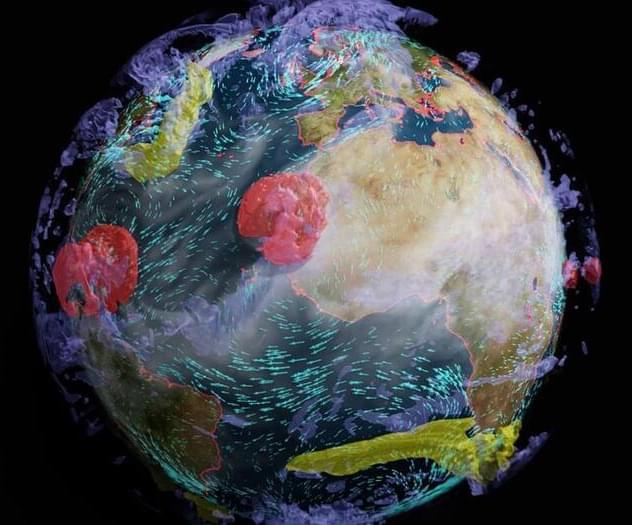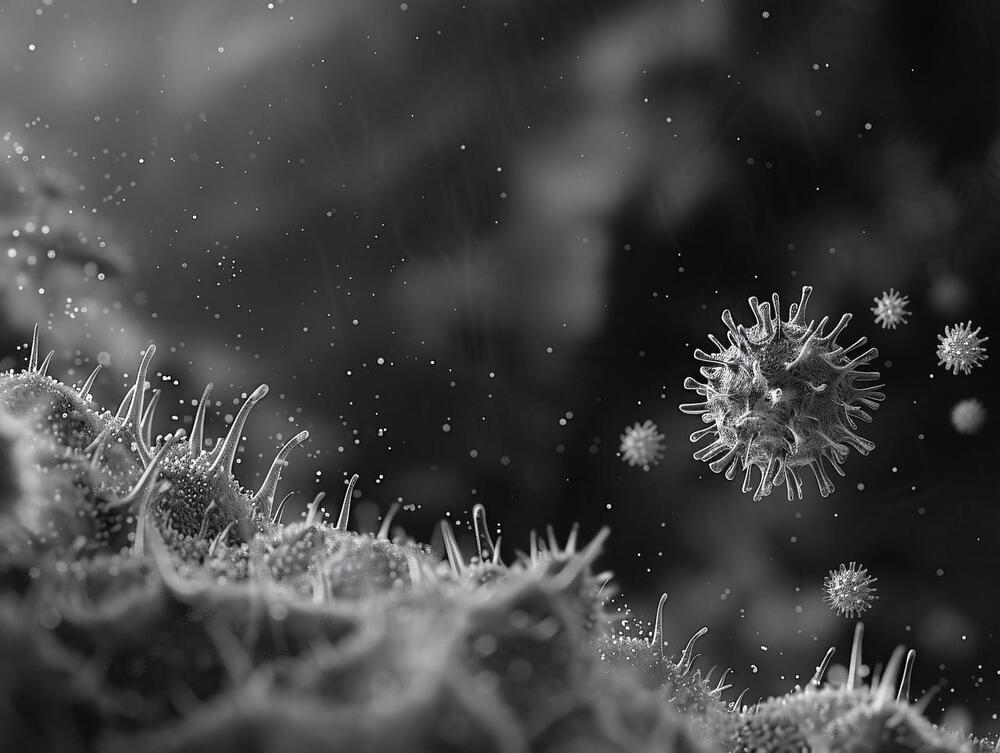In a new study, scientists propose the concept of “virtual quantum broadcasting,” which provides a workaround to the longstanding no-cloning theorem, thereby offering new possibilities for the transmission of quantum information.
Chipmaker Nvidia has shown off a clone of our entire planet that could help meteorologists simulate and visualize global weather patterns at an “unprecedented scale,” according to a press release.
The “Earth climate digital twin,” dubbed Earth-2, was designed to help recoup some of the economic losses caused by climate change-driven extreme weather.
Customers can access the digital twin through an API, allowing “virtually any user to create AI-powered emulations to speed delivery of interactive, high-resolution simulations ranging from the global atmosphere and local cloud cover to typhoons and turbulence.”
Four Lawrence Livermore National Laboratory (LLNL) researchers have partnered with Los Angeles-based SoCalGas and Munich, Germany-based Electrochaea to develop an electrobioreactor to allow excess renewable electricity from wind and solar sources to be stored in chemical bonds as renewable natural gas.
When renewable electricity supply exceeds demand, electric-utility operators intentionally curtail production of renewable electricity to avoid overloading the grid. In 2020, in California, more than 1.5 million megawatt hours of renewable electricity were curtailed, enough to power more than 100,000 households for a full year.
This practice also occurs in other countries. The team’s electrobioreactor uses the renewable electricity to convert water into hydrogen and oxygen. The microbes then use the hydrogen to convert carbon dioxide into methane, which is a major component of natural gas. Methane can then be moved around in natural gas pipelines and can be stored indefinitely, allowing the renewable energy to be recovered when it is most needed.
The brain has effectively proven a powerful inspiration for the development of computing architectures in which processing is tightly integrated with memory, communication is event-driven, and analog computation can be performed at scale. These neuromorphic systems increasingly show an ability to improve the efficiency and speed of scientific computing and artificial intelligence applications. Herein, it is proposed that the brain’s ubiquitous stochasticity represents an additional source of inspiration for expanding the reach of neuromorphic computing to probabilistic applications. To date, many efforts exploring probabilistic computing have focused primarily on one scale of the microelectronics stack, such as implementing probabilistic algorithms on deterministic hardware or developing probabilistic devices and circuits with the expectation that they will be leveraged by eventual probabilistic architectures. A co-design vision is described by which large numbers of devices, such as magnetic tunnel junctions and tunnel diodes, can be operated in a stochastic regime and incorporated into a scalable neuromorphic architecture that can impact a number of probabilistic computing applications, such as Monte Carlo simulations and Bayesian neural networks. Finally, a framework is presented to categorize increasingly advanced hardware-based probabilistic computing technologies.
Keywords: magnetic tunnel junctions; neuromorphic computing; probabilistic computing; stochastic computing; tunnel diodes.
© 2022 The Authors. Advanced Materials published by Wiley-VCH GmbH.
Probabilistic computing with stochastic devices.
In recent decades, artificial intelligence has been successively employed in the fields of finance, commerce, and other industries. However, imitating high-level brain functions, such as imagination and inference, pose several challenges as they are relevant to a particular type of noise in a biological neuron network. Probabilistic computing algorithms based on restricted Boltzmann machine and Bayesian inference that use silicon electronics have progressed significantly in terms of mimicking probabilistic inference. However, the quasi-random noise generated from additional circuits or algorithms presents a major challenge for silicon electronics to realize the true stochasticity of biological neuron systems. Artificial neurons based on emerging devices, such as memristors and ferroelectric field-effect transistors with inherent stochasticity can produce uncertain non-linear output spikes, which may be the key to make machine learning closer to the human brain. In this article, we present a comprehensive review of the recent advances in the emerging stochastic artificial neurons (SANs) in terms of probabilistic computing. We briefly introduce the biological neurons, neuron models, and silicon neurons before presenting the detailed working mechanisms of various SANs. Finally, the merits and demerits of silicon-based and emerging neurons are discussed, and the outlook for SANs is presented.
Keywords: brain-inspired computing, artificial neurons, stochastic neurons, memristive devices, stochastic electronics.
Third Generation 5 nm Wafer Scale Engine (WSE-3) Powers Industry’s Most Scalable AI Supercomputers, Up To 256 exaFLOPs via 2048 Nodes.
SUNNYVALE, CALIFORNIA – March 13,202 4 – Cerebras Systems, the pioneer in accelerating generative AI, has doubled down on its existing world record of fastest AI chip with the introduction of the Wafer Scale Engine 3. The WSE-3 delivers twice the performance of the previous record-holder, the Cerebr as WSE-2, at the same power draw and for the same price. Purpose built for training the industry’s largest AI models, the 5nm-based, 4 trillion transistor WSE-3 powers the Cerebras CS-3 AI supercomputer, delivering 125 petaflops of peak AI perform ance through 900,000 AI optimized compute cores.
Key Specs:
The human genome is primarily composed of long stretches of repeat nucleotides that do not code for protein (only about two percent of the human genomes does code for protein). This mysterious, non-protein-coding DNA was once disregarded as junk DNA, but scientists have begun to find sequences of importance within this ‘junk,’ which is now sometimes called genomic ‘dark matter.’ Some of these sequences appear to have important regulatory functions, and can control the expression of some protein-coding genes. But studying these sequences can be extremely challenging, particularly because they are not like protein-coding genes that can be studied with standard techniques.
But scientists have now found a great use for the dark genome. Reporting in Science Translational Medicine, researchers created a method to reveal elements of the dark genome in cancerous tissue and in the bloodstream, as fragments called cell-free DNA (cfDNA). These bits of DNA are lost from tumors and they move around the body in the bloodstream. This technique may eventually help scientists or clinicians identify cancer or monitor the progress of treatment.
The immune system is a complex network of various cell types all working cohesively to identify and eliminate foreign invaders. Unfortunately, if a disease is strong enough or our immune system is not well equipped to accurately target the disease, we get sick until the immune system builds a strong enough immune response toward it. A great example includes vaccine biology. We are given an attenuated form of a disease and our body, not exposed to it before, will recognize the markers on the outside of the virus and make antibodies against it. Consequently, the immune system will build up a strong enough immune response to completely eradicate the disease from the body and also maintain memory cells that will instantly recognize future exposures of the same disease.
Different immune cells play various roles that effectively elicit an immune response. Innate immunity is the first barrier against disease. Cells in this barrier are non-specific and target a broad range of diseases but are less potent. Additionally, they take the protein or antigen from the disease and present it to more specific and effective immune cells in the adaptive immune system. These highly specific cells are mainly responsible for killing or lysing the disease. Cells in the adaptive immune system include T cells and B cells. T cells are a broad cell population with different responsibilities within each T cell subset. However, CD8+ T cells are the classic T cell subtype solely responsible for lysing foreign or invading cells. The field of T cell biology is ever expanding as scientists discover new ways to improve their function and effectively target disease.
A recent article published in the Journal of Immunology, by Dr. Tadashi Matsuda and others, discovered that a new protein, known as STAP-1, improves T cell activation. Matsuda, senior author on the paper, is a Professor and Principal Investigator at Hokkaido University in Japan. His work focuses on T cell biology and intracellular components of cellular immunity. Signal-Transducing Adaptor Protein-1 or STAP-1 was implicated as a mediator between intracellular proteins and eliciting an immune response. Interestingly, STAP-1 upregulates T cell receptor (TCR)-mediated T cell function and increased inflammatory response. Matsuda and others found that STAP-1 generates the activation of downstream signaling pathways associated with stronger T cell activity. While this may have seemed like a great marker to improve immune response, the team also discovered that knocking out STAP-1 reduces autoimmune disorder symptoms. Therefore, treatment application is context dependent.
Apptronik is working with NVIDIA’s Project GR00T to enable general-purpose humanoid robots to learn complex tasks.








